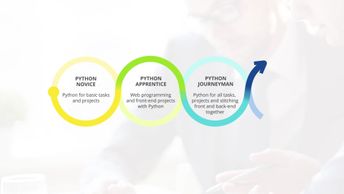Aspire Python Novice to Pythonista Pythonista Track 4: Pythonista
Final Exam: Pythonista will test your knowledge and application of the topics presented throughout the Pythonista track of the Aspire Python Novice to Pythonista Journey.
| Objectives |
Final Exam: Pythonista - access individual cells programmatically using openpyxl
- alter the weight and line style of data series to customize the appearance of a visualization
- analyze the state of an application in the middle of code execution with the use of breakpoints
- apply sophisticated styles and alignments to format cell contents
- apply styling elements to control the display of data in cells
- assign names to groups of cells and use those names in formulae to enhance readability
- build a Python app to break up a large text file into chunks and send the chunks over a socket connection to a recipient app
- code a Python app to receive a large text file in chunks and reconstruct that file
- configure an application to wait for a set amount of time for communication from another process
- create a Microsoft Excel workbook by choosing from a list of templates
- create a Microsoft Excel workbook using the openpyxl library
- customize syntax highlighting for various source files in your Python project
- describe the basic principles of good design in code
- describe the Chain of Responsibility pattern and how it is used
- describe the Command pattern and its use cases
- describe the design of the Decorator pattern and its advantages
- describe the design of the Flyweight pattern and why it is used
- describe the design of the Proxy pattern
- describe the design of the Proxy pattern and list its use cases
- describe the Liskov's Substitution, Interface Segregation, and Dependency Inversion principles of good design
- describe the Observer pattern and when it should be used
- describe the principle of Least Knowledge
- describe the principle of the Hollywood principle of good design
- describe the Single Responsibility and Open/Closed principles of good design
- describe the Strategy pattern and its use cases
- describe the use the socket module in a Python application
- implement a simple design for the Factory pattern
- implement the Singleton pattern using global objects in Python
- insert formulae into Excel workbooks
- insert images into Microsoft Excel files and control their size and location
- install and configure the PyCharm IDE on your system
- minimize typing errors by using the auto-complete feature
- recall how the Builder pattern works and when it should be used
- recall how the Factory and Abstract Factory patterns work and when they can be used
- recall how the Object Pool pattern works and when it should be used
- recall how the Singleton pattern works and when to use this pattern
- recall the basic principles of good design in code
- recall the Single Responsibility and Open/Closed principles of good design
- recognize the Command pattern
- recognize the design of the Adapter pattern and when it should be used
- recognize the effects of setting sockets to run in blocking mode
- recognize the effects of setting sockets to run in blocking mode when large transfers are involved
- recognize the need for the Adapter pattern
- recognize the need for the Adapter pattern when working with legacy components
- recognize the Singleton pattern
- save the contents of an in-memory representation to a Microsoft Excel file
- save the contents of an in-memory representation to a Microsoft Excel file on disk
- specify rows and columns that always ought to be on-screen as a user browses an Excel file
- transmit an image file from one Python app to another by breaking it up into chunks
- use Microsoft Excel to visualize data
- use number formats to represent currencies and add comma separators
- use openpyxl to construct visualizations in Excel
- use openpyxl to construct visualizations in Excel workbooks
- use openpyxl to programmatically construct formulae
- use openpyxl to programmatically construct formulae in workbooks
- use the resume button to ensure that code execution only pauses at breakpoints
- use the socket module in a Python application
- use the socket module in a Python application to get information about the application's host
- visualize data using Microsoft Excel
- write code to implement the Chain of Responsibility pattern
|


